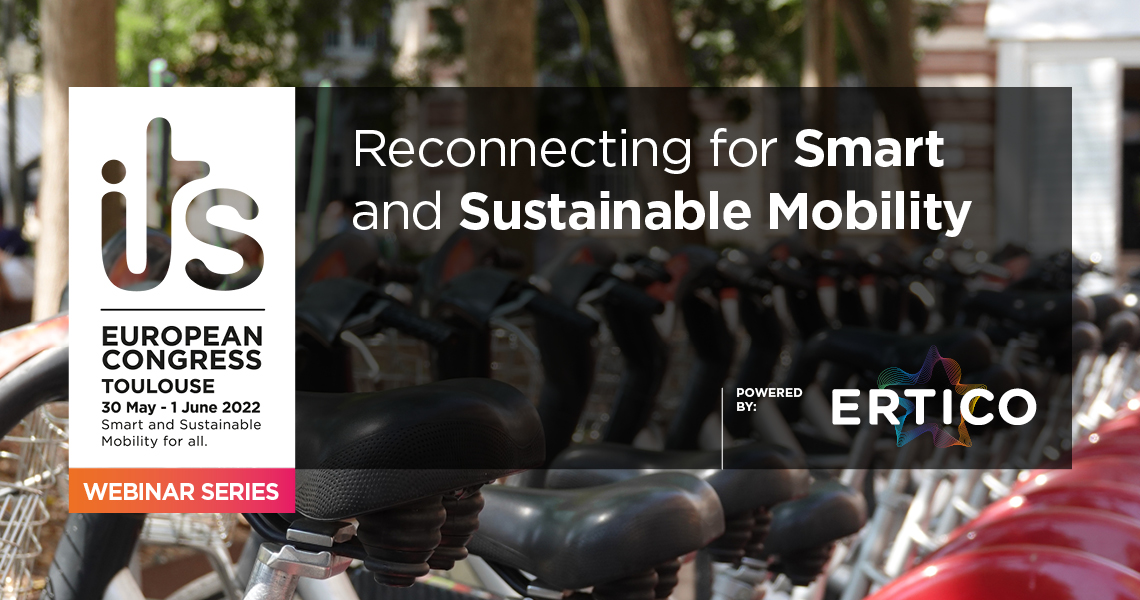Smarter and more sustainable mobility will be achieved based on multiple inter-connecting factors, not least cutting-edge technology to support innovation and create next-generation solutions: from AI, automation and autonomous vehicles to mobility data and digital enablers such as 5G and 6G.
These topics were explored by an expert panel in the latest webinar ahead of the ITS European Congress, which takes place at the MEETT Exhibition and Conference Centre in Toulouse, 30 May to 1 June. ‘Next-generation solutions’ is one of the main Congress topics this year.
“Future smart mobility requires leading-edge technology and connecting the dots in terms of vehicles, technology, infrastructure, people and goods,” says Joost Vantomme, CEO of ERTICO-ITS Europe. Solutions being developed, tested and deployed now – including projects and platforms managed by ERTICO – are shaping the future of traffic management and traffic efficiency, safer roads, logistics, and cleaner greener transport. Mobility data, edge computing, artificial intelligence and cyber-resilient infrastructure are important elements in providing these solutions.
All about the data
“In next-generation solutions, data is the common denominator: using data and information to benefit moving people and goods, in urban mobility, autonomous transport, platooning, and so on,” says Coen Bresser, Senior Manager of Innovation and Deployment, ERTICO-ITS Europe. He points to the importance of FAIR Data Principles around data availability, accessibility, interoperability and useability. ERTICO innovation platforms and partnerships cover all these areas.
The work of Dutch C-ITS data aggregator Monotch illustrates the critical role of data, plus the need to move from trials to mass deployment: “Next-generation Cooperative Intelligent Transport Systems mean serving a massive audience compared to previously, and having a far greater impact,” says Menno Malta, Monotch CEO and founder. “This is a multi-stakeholder ecosystem, with many data providers and consumers. And while C-ITS has made huge progress, technical and organizational obstacles remain that can block the large-scale deployment.”
Designed to overcome these barriers, the Monotch TLEX platform is, he says, a game-changer. Three large-scale live use cases are deployed in 29 of the Netherlands’ 40 main cities, with two million active vehicles connected in the ecosystem and more than 1 billion C-ITS data exchanged every day. Benefits seen include a 15.5% reduction in CO2 emissions, a 10% reduction in travel times, and an estimated 4.4% reduction in fatalities and a 4.8% reduction in injuries. Monotch is presenting and exhibiting in Toulouse.
Safer roads
Continuing the safety theme, ERTICO partner and Toulouse exhibitor PARIFEX has adopted 3D LiDAR (Light Detection and Ranging) tech to strengthen its speed control systems. Its approach combines 3D LiDAR with a camera, image processing and AI to make roads safer in multiple settings, providing a 360-degree field of view, speed measurement, classification, identification, tracking and accurate data collection, all in real time.
“We place great importance on innovation, and road accidents and mortality rates are a major concern: we want to protect all users and especially the most vulnerable,” says Nathalie Deguen, PARIFEX speed enforcement department. 3D LiDAR provides increased control, with the multifunctional NANO-CAM sensing solution providing efficiency and precision. This approach can be applied in diverse applications including traffic management and autonomous vehicle projects, helping future mobility to be smarter and safer.
Towards CAD safety assurance
“Connected & Automated Mobility has the potential to make transport safer, greener and more accessible, but only if it’s done right,” adds Tom Alkim, Strategic Adviser CCAM at traffic and mobility management service provider MAPtm, which is part of the Traffic Management for Connected and Automated Driving (TM4CAD) project consortium. “Questions remain, including how to integrate connected and automated vehicles (CAVs) into broader transport systems, and how they interact with other forms of mobility”.
In this context, Operational Design Domain (ODD) describes the combination of operating conditions under which a driving automation system or feature is designed to function. Gaps emerge, however, usually due to changes in infrastructure, traffic conditions and weather. To help overcome those gaps, TM4CAD is exploring Distributed ODD Awareness for CAD systems. This means vehicles are aware of their surroundings – scenery, environments, dynamic elements – via maps, vehicle sensors, roadside equipment and more, with information about different attributes also coming from third parties. Data and connectivity are, again, core requirements.
Making ITS tangible in Toulouse
The three-day ITS European Congress combines a high-level programme, comprehensive exhibition and detailed technical agenda, with more than 300 submissions received across the main Congress themes: next-generation solutions; services for citizens; green and sustainable mobility; from large scale trials to deployment; and cities as logistics hubs. “Our opening ceremony will feature a fantastic inspirational speaker, the Toulouse-based astrophysicist Dr Sylvestre Maurice, who discovered ice on the Moon and water on Mars,” says Lisa Boch-Andersen, Director of Communications, Congresses & Events, ERTICO-ITS Europe.
The Congress also includes the ITS Summit: a rare opportunity for industry leaders and senior representatives from the local and national government to meet and discuss ITS issues in roundtables. Topics to be explored include data ownership and access to data, inclusion and the digital divide, data sharing, and interoperability. Lisa adds, “Registration for the Congress is open now, and we hope to see you in Toulouse.”
Watch the full recording of the second webinar here.
Learn more about the 2022 ITS European Congress.
Registrations are open – get your ticket before the early bird deadline: 19 April.
The Congress app launches on 1 May and the event opens Monday 30 May.
